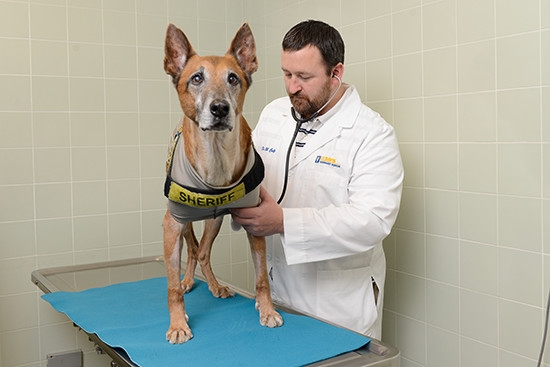Innovative canine prostate cancer treatment yields success

William T.M. Culp, VMD, DACVS, examines Kopper.
Fourteen percent of men will develop prostate cancer. Ninety-nine percent of them will survive, thanks to treatment advances. And now, male canines with the same condition can take advantage of one of those advances.
The University of California at Davis (UC Davis) is conducting a clinical trial to evaluate a new prostate cancer procedure similar to one in human medicine known as prostatic transarterial embolization. Unlike other prostate cancer therapies, this one is minimally invasive.
The latest patient is Kopper, a 14-year-old Belgian Malinois and retired K-9 officer. Since his surgery, his prostate has decreased and he’s doing well. The procedure has been performed on six dogs to-date, and all six showed improvement of their prostate issues.
How the treatment works: the prostate tumor and associated blood supply are assessed via CT and MRI scans. Once the blood supply is mapped, the tumor is accessed minimally invasively, using interventional radiology techniques that utilize fluoroscopic guidance (real time “x-rays”). Catheters are placed, and the blood supply to the tumor is identified.
Material is then injected into the blood vessels supplying the tumor, which causes a blockage of the vessels and cuts off the blood supply and accompanying nutrients to the tumor.
The size of the gland and tumor decrease as cells die from lack of blood supply.
The hope, with all such treatments, is a decrease in tumor size that will improve the quality and length of their lives.
William T.M. Culp, VMD, DACVS, a board-certified surgeon who specializes in interventional radiology at the UC Davis Veterinary Medical Teaching Hospital, is pioneering the work.
The trial is ongoing. (The procedure has been performed on six dogs to-date.) Dogs with naturally occurring prostate cancer are being recruited to evaluate the effectiveness of prostatic transarterial embolization as an accepted standard-of-care procedure.
Photo courtesy of the University of California at Davis



